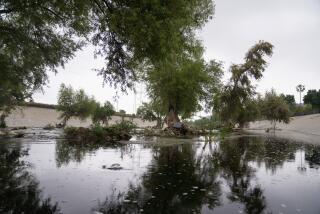Hydro power
- Share via
Waterfronts are often known as the ugly part of town, but many cities view the blighted rivers and bays as liquid assets that can stimulate the economy and improve quality of life. Boats, lots of pleasure boats, figure prominently into the strategy.
Redevelopment projects underway nationwide are enticing park-and-play boaters with cultural centers and parks, restaurants and shops, often within walking distance of the docks.
“The marinas are gateways to fishing, boating recreation, tourism to visit shorelines and islands, and environmental education,” says Clara Irazabal, assistant professor of urban design and planning at USC. Waterfront revitalization allows cities to “reconnect to their origins and nature,” she says.
Stockton is in the midst of a $120-million renovation of the San Joaquin River waterfront where the river glides past downtown heading to the California Delta. With about 2,000 new slips, boaters can dock near sports arenas, a movie theater complex and a 150-room hotel. Work is expected to be completed next fall.
“People can come in on their boats and tie up to the hotel,” says Stockton city spokesman Matt Robinson.
Tacoma, Wash., is converting its rundown waterfront into the vibrant Thea Foss Waterway, centerpiece of a $150-million redevelopment project. Formerly a hazardous waste site off Commencement Bay, the area now features the 500-foot Bridge of Glass, modern sculptures, the Museum of Glass and a 90-foot, metal-clad tower that evokes a wood burner used by the timber industry. Visitors can access the waterfront via dozens of boat slips and ride light-rail transit to the nearby downtown shopping and theater districts.
“[Boaters] see blue trails on a waterway the same way you see trails or pedestrian pathways on land. This is giving the public access to their waterway,” says Sue Dowie, director of planning and operations for the Foss Waterway Development Authority.
In Pittsburgh, defunct steel mill sites along the three rivers snaking through the city have been reborn as sports stadiums, parks, marinas and entertainment complexes. The upgrades helped Pittsburgh lure the 2005 Bassmasters Classic, which can pull in 100,000 visitors for the three-day Super Bowl of bass fishing.
“The powers that be recognize the economic impact of recreation boaters and how they benefit businesses,” says Andy Talento, general manager of the Tri-River Marine Trade Assn.
About 90% of the world’s major cities sit on the shorelines of oceans, lakes and rivers. Once-thriving centers for commerce, coastal defense, industry and fishing, many urban waterfronts lost businesses and people as cities pushed out from the core toward suburbs and new transportation centers. The 1960s environmental movement triggered cleanup efforts, and the decline of steel and some heavy industry in the Rust Belt during the ‘80s prompted officials to seek new, more profitable uses for waterfronts.
There are 17 million pleasure boats in the United States and 72 million people participated in recreational boating in 2003, according to the National Marine Manufacturers Assn. While many people use their vessels to sail over the horizon or escape in Great Lakes and giant Western reservoirs, many fall into the category of urban boaters.
City boaters motor to shorefront restaurants in San Diego, pluck a Barry Bonds “splash” ball out of McCovey Cove in the San Francisco Bay, party on yachts off Newport Beach and festoon the cabin cruiser with lights for the Christmas boat parade in Ventura Harbor.
Also, people rediscover the grandeur of a metropolis such as Chicago, New York City or San Francisco when viewing it framed by water.
“It’s a beautiful skyline from that view from the water,” says Irene McCormack, spokeswoman for the Port of San Diego. “It’s a breath of fresh air to get out of the city and look at it from afar and see the treasure you live in.”
More to Read
Sign up for The Wild
We’ll help you find the best places to hike, bike and run, as well as the perfect silent spots for meditation and yoga.
You may occasionally receive promotional content from the Los Angeles Times.










